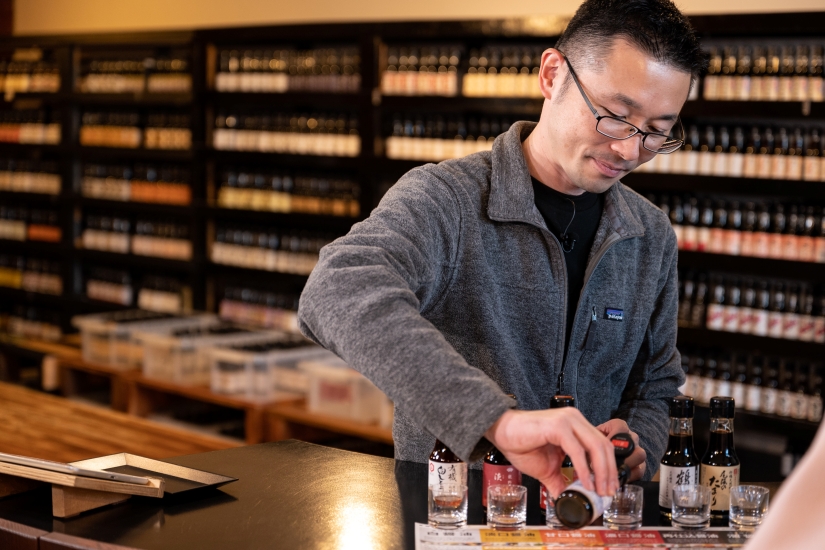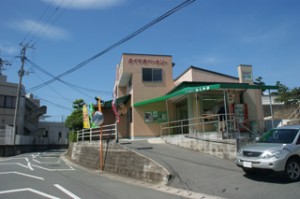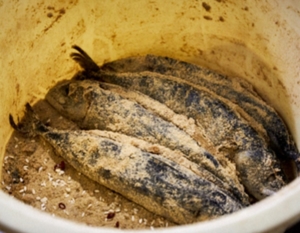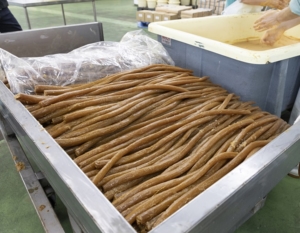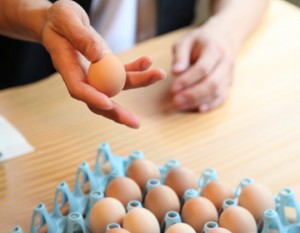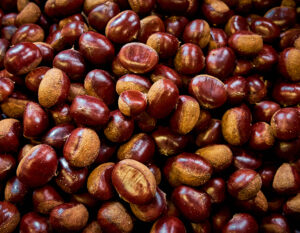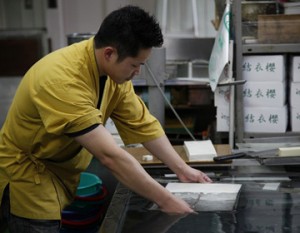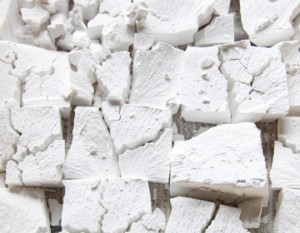Soy sauce is a traditional industry that has been handed down through the years. There is a man who has made it his mission to promote the appeal of soy sauce, which is indispensable to Japanese food culture, and has visited more than 400 soy sauce breweries throughout Japan. Mr. Mantaro Takahashi is the representative of Traditional Design Studio, Inc. which develops the “Shokunin Soy Sauce” brand.
A select store offering the finest selection of soy sauce

Shokunin Shoyu has its head office in Maebashi City, Gunma Prefecture, where Mr. Takahashi was born and raised. Maebashi, also known as the prefectural capital, is located at the northernmost tip of the Kanto Plain, and is a core city where the city and nature are in harmony, nurtured by the majestic nature of Mount Akagi and the abundant water of the Tone River. On the first floor of a condominium in a quiet residential area stands a store that stands out from the crowd. The storefront is covered by a massive wooden exterior wall that resembles a soy sauce warehouse, and is marked by a graphical logo.

Once inside the store, the walls are filled with small bottles of a wide variety of soy sauces with colorful labels. Mr. Takahashi visits soy sauce breweries all over Japan to select from about 100 different brands. The store also offers food pairing suggestions and tastings from among the many varieties of soy sauce available. It is truly a soy sauce specialty store, a one-of-a-kind soy sauce boutique.
We want to shine a light on traditional and local industries.
I had a vague idea that I wanted to start some kind of business,” he said. After graduating from college, Mr. Takahashi worked for a precision optical equipment manufacturer, and after three years of sales experience, he quit the company. However, he had no specific plan in mind, but rather a passionate desire to start a business that he kept in his heart. In order to find what he wanted to do, Mr. Takahashi embarked on a journey that took him all over Japan.
As he searched for what he could do, relying on the sales skills he had cultivated as a manufacturer, he glimpsed the reality of traditional and regional industries that lacked the ability to communicate, despite their confidence and pride in their craftsmanship. Takahashi came to the realization that “this is where I should be working. He narrowed his focus to traditional industries that were more familiar to him and that he had not yet been able to “select and buy” and eventually arrived at the profound world of soy sauce.
Thus began his days of visiting soy sauce breweries all over Japan, getting in touch with the brewers, and learning more and more. The common denominator among the breweries is that they are making good products, but they are not selling well. But they don’t sell well. Even though they carefully craft their products with carefully selected ingredients, they sell them at the same price as mass-produced products, saying, “We can’t charge a high price for something we use every day. The small brewery’s small production volume also made it difficult for them to get their products into major distribution channels. We found problems in the soy sauce industry, which has not done enough to make its products known to consumers.
The idea of specializing in mini bottles

All soy sauce is standardized into small 100ml bottles and sold with the brewery’s original label. This is the original size of artisan soy sauce. The idea for this was inspired by the “difficulty” Takahashi experienced when buying soy sauce in the stores. The size of a typical one-liter bottle is quite intimidating to try out,” he says. In the end, you end up choosing the same thing as usual. Small bottles are easy to pick up, and you can buy several bottles at the same time to compare tastes. When we find a soy sauce we like, we tell them to buy it directly from the brewer,” says Takahashi.
It started with a small number of soy sauce breweries that thought it would be “fun” and willingly agreed to sell small bottles. Gradually, the number was increased, and now the company handles 100 brands from breweries all over Japan. Starting with Internet sales, Craftsman Soy Sauce has established a new sales style and is steadily expanding its sales channels, from the main store in Maebashi to a storefront at Ginza Matsuya in Tokyo, and wholesale sales to department stores, supermarkets, and general merchandise stores.
Soy sauce, which is used every day but surprisingly unknown

By the way, every Japanese household is sure to have soy sauce. It is a familiar seasoning that everyone uses for cooking and eating as a matter of course. It is easily available at the supermarket, and when a bottle of soy sauce is about to run out, people buy another bottle of the same one they have been using without hesitation. Many households are probably like that.
When asked again, “What exactly is soy sauce?” we realize that we know surprisingly little about soy sauce, even though we use it every day. Although soy sauce is a seasoning that supports Japan’s food culture, the general public’s knowledge of soy sauce is unfortunately limited. Soy sauce is just soy sauce, and they probably use it without much awareness. They may not even think about using different types of soy sauce for different ingredients,” says Takahashi.
Chiba Prefecture is the largest producer of soy sauce in Japan
First of all, do you know where soy sauce comes from? There are approximately 1,100 soy sauce manufacturers in Japan. A comparison of shipments by prefecture shows that Chiba Prefecture, home to three major soy sauce makers (Kikkoman, Yamasa Soy Sauce, and Higeta Soy Sauce), is by far the largest producer. Hyogo Prefecture is in second place. These two prefectures alone account for more than 50% of the market share. Gunma Prefecture, where Shokunin Soy Sauce is based, comes in a close third, followed by Aichi Prefecture in fourth, and Kagawa Prefecture in fifth.
What are the main ingredients of soy sauce?
Soy sauce is made from three basic ingredients: soybeans, wheat, and salt. Microorganisms such as koji mold, lactic acid bacteria, and yeast play an important but invisible role. Fermentation by microorganisms is the key to the mellow aroma and umami characteristic of soy sauce, which is a fermented seasoning that takes from six months to two or three years to make. Even if the same ingredients are used to make soy sauce, the microbial ecosystem differs from one soy sauce maker to another. The interesting thing about making soy sauce is that it never tastes the same.
Soy sauce is divided into five types, and regional characteristics are deeply involved

According to JAS (Japanese Agricultural Standards), soy sauce is classified into five types: dark, light, re-finish, tamari, and white. The most common type is koikuchi soy sauce. This type accounts for about 80% of the total distribution volume.
Soy sauce also has regional characteristics. The presence of dashi, an essential ingredient in Japanese food culture, seems to have had no small influence on the production of soy sauce in each region. In western Japan, where kelp broth is the base, light soy sauce is used for cooking, while in eastern Japan, where bonito broth is the base, all-purpose dark soy sauce is the norm.
The saltiness of soy sauce is also a regional characteristic. In regions by the sea, such as Kyushu and the Sea of Japan, sweet soy sauce made with amino acid solution and sweetener is preferred, and fresh fish is served with sweet, thick soy sauce. On the other hand, inland areas tend to favor salty soy sauce.
Furthermore, the Chubu region is home to a variety of fermented foods such as sake, mirin, vinegar, and miso. The two extremes of soy sauce coexist in the Chubu region: thick tame shoyu, which has a long maturation period and concentrated umami flavor, and light shiro shoyu, which has a short maturation period and is lighter in color.
Using different types of soy sauce expands the world of food

According to Mr. Takahashi, “It is a waste to use only the same soy sauce. If you use different types of soy sauce for different dishes and ingredients, it will taste better and be more enjoyable. In addition to the five JAS-standard types of soy sauce, Craftsman Soy Sauce also offers a unique classification of six types of soy sauce, including sweet soy sauce. In order of shortest maturity, they are: white, light, sweet, dark, re-fermented, and tame. He says it is easy to understand the characteristics of these three types by dividing them into three broad categories.
First, the short maturation periods, from six months to a year, are for light-colored, high-salted, and full of the flavors of the ingredients. Next, sweet and dark types can be easily matched with ingredients, and can be used in cooking or poured over food.
The remaining two types, re-finishing and tamari, have a longer maturation period of two to three years and are unique. The other is tame, which contains more soybeans and less water, and has a richer color and flavor. It can be used like a sauce, and you can enjoy the sense of unity with the ingredients.
Soy sauce is much like wine.
I am often asked by customers, ‘Which soy sauce goes best with sashimi? We often get questions from customers about which soy sauce goes best with which sashimi,” says Takahashi, ”but there are different types of soy sauce that go well with red and white fish. It’s easier to understand if you think of shiro shoyu and awakuchi shoyu as white wine-based, while re-finished shoyu and tame shoyu are red wine-based,” says Takahashi. Just as there are wine pairings, such as a crisp white wine for white fish and a rich red wine for red meat, so too there are food pairings for soy sauce. By using different soy sauces for different dishes and ingredients, the range of enjoyment will expand even further.
You can find a bottle that complements your food.

In order to make the soy sauce selection process more intuitive, we have devised something like this. It is called “Daikoubutsu Soy Sauce”(favorite soy sauce), which suggests combinations of soy sauces selected by Mr. Takahashi from all over Japan and foods that go well with them. The food illustrations on the package are placed over the bottle label, making them easy to spot. The lineup includes 24 varieties, including sashimi, egg over rice, pork cutlet, fried egg, toast, and more. The familiar illustrations and the interest in favorite foods make casualness and ease a priority, and succeed in lowering the hurdle for choosing soy sauce.
What is the vision of the future of soy sauce that Artisan Soy Sauce aims for?

When Mr. Takahashi first entered the soy sauce industry, there were approximately 1,600 soy sauce makers, but today there are fewer than 1,100, and soy sauce production is on a downward trend. Only about 1% of all soy sauce is made in wooden vats. Even so, about 60% of the soy sauce handled at Shokunin Soy Sauce is made in wooden vats.
Mr. Takahashi insists on using wooden vats because the microorganisms that live in the vats bring a unique flavor to the soy sauce during the fermentation process. The result is a unique soy sauce that reflects the characteristics of the brewery. In other words, the brewery’s attitude toward soy sauce production is directly reflected in the soy sauce. Wooden bucket brewing, which tends to produce a blurred finished product, can lead to a drop in soy sauce quality if it is not properly managed.
I believe that both the products mass-produced in factories by large manufacturers and the handmade soy sauce produced by small soy sauce breweries have their advantages and disadvantages. The great thing about the big companies is that the quality is always stable. On the other hand, small breweries have a large swing in quality. But I find that interesting. Mr. Takahashi also finds value in the stories of hardships experienced by brewers who repeatedly go through trial and error.
Recently, he says, the number of young brewers who view soy sauce made in wooden vats, which has its own unique flavor and aroma, in a positive light is gradually beginning to increase. It’s very similar to the craft beer movement,” says Takahashi. There is a glimmer of hope for the future of soy sauce breweries, which have been shrinking.
There is sure to be overseas demand for unique and particular “craft soy sauce,”” says Takahashi, who is also considering exporting soy sauce to other countries to expand Japan’s deep soy sauce culture to the rest of the world. Mr. Takahashi’s challenge to connect the brewer and the user has only just begun.



